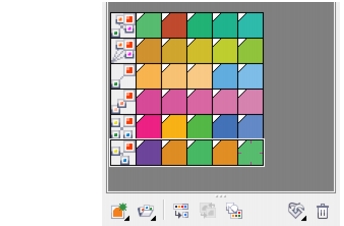Quick links to procedures on this page:
• |
• |
| Premium feature |
In Update 2, the Color styles docker (Window ![]() Dockers
Dockers ![]() Color styles) features enhancements that will help you create and edit color harmonies and color styles.
Color styles) features enhancements that will help you create and edit color harmonies and color styles.
If you are new to color styles and color harmonies, we recommend that you first see Working with color styles.
You can apply a rule to a color harmony to shift all colors according to predetermined logic and create various color schemes (combinations). The selected color in the color harmony is considered to be the base color and is used as reference to position the remaining colors on the color wheel.
You can also use a harmony rule to create a color harmony from scratch. The resulting color harmony contains five colors that are created randomly based on the chosen rule, and its base color is the selected color in the harmony swatch list.
The following harmony rules are available.
• |
Analogous — includes colors that are next to each other on the color wheel,
creating clear and smooth color schemes
|
• |
Analogous - Accented — similar to the Analogous rule, but includes a
complementary (contrasting) color in addition to the adjacent colors
|
• |
Complementary (also known as “contrast”) — balances the base color with the
opposite color on the color wheel. Warm and cold colors are created for vibrant
and energetic color schemes.
|
• |
Monochromatic — includes variations of a single color, creating soothing color
schemes
|
• |
Tetrad — based on a pair of colors and their complements on the color wheel.
This rule usually creates bold color harmonies and requires careful planning when
used.
|
• |
Triad — balances the base color with colors that are situated close to the
opposite end of the color wheel, forming a triangle. This harmony rule usually
creates color schemes of soft contrast.
|

Examples of color harmonies created from scratch by using harmony rules

The icons on the harmony folders show that the color harmonies are based on different harmony rules. From top to bottom: Analogous - Accented, Analogous, Complementary, Monochromatic, Tetrad, and Triad.
You can edit color harmonies in various ways: by removing a previously applied harmony rule, by substituting the base color with the opposite color on the color wheel, by moving colors to different arms on the color wheel, and by dragging the color harmony on the color wheel.
You can select colors from multiple color harmonies and edit them simultaneously. This feature lets you edit multiple rule-based color harmonies at the same time without removing the rules.
In addition, you can now convert a color style to the Grayscale color mode from within the Color styles docker. For more information about editing color styles, see Editing color styles.
| To apply a rule to a color harmony |
1. |
Click Tools |
2. |
In the Color styles docker, click a harmony folder.
|
3. |
Choose a rule from the Harmony rule list box.
|
You can choose Custom from the Harmony rule list box to remove a
previously applied rule or start a new harmony folder.
|
| To edit a color harmony |
1. |
Click Tools |
2. |
In the Color styles docker, click a color style in a color harmony.
|
3. |
In the Harmony editor, perform any of the following tasks.
|
You can also convert a color style or a color harmony to the Grayscale color
mode in the Create color styles docker when you are creating a color style or
a color harmony from a selected object. For information about how to access
the Create color styles docker, see To create a color style or harmony from a
selected object.
|
|
|
Copyright 2012 Corel Corporation. All rights reserved.